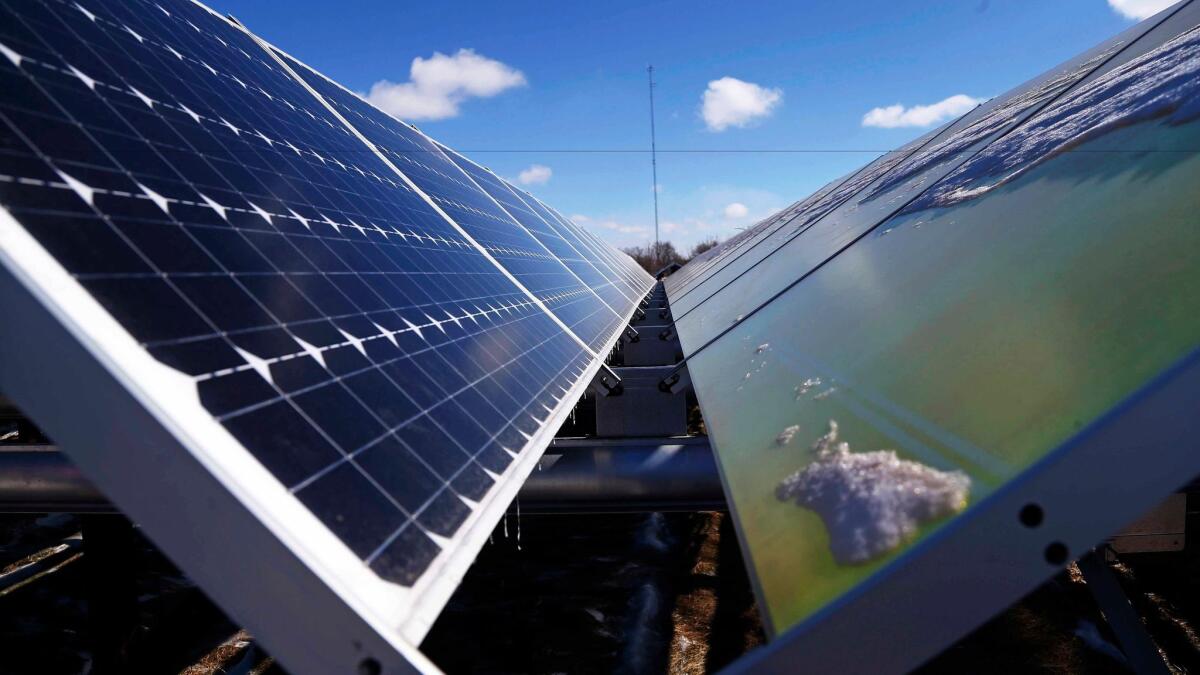U.S. utilities seek solar power as Trump sides with coal, fossil fuels

- Share via
The plunging cost of solar power is leading U.S. electric companies to capture more of the sun just when President Donald Trump is moving to boost coal and other fossil fuels.
Solar power represents just about 1% of the electricity U.S. utilities generate today, but that could grow substantially as major electric utilities move into smaller-scale solar farming, a niche developed by local cooperatives and nonprofits.
It’s both an opportunity and a defensive maneuver: Sunshine-capturing technology has become so cheap, so quickly, that utilities are moving to preserve their core business against competition from household solar panels.
“Solar growth is so extensive and has so much momentum behind it that we’re at the point where you can’t put the genie back in the bottle,” said Jeffrey R.S. Brownson, a Pennsylvania State University professor who studies solar adoption. “You either learn how to work with this new medium, solar energy, or you’re going to face increasing conflicts.”
The transition away from coal-burning power plants now seems unstoppable, even if Trump scraps rules requiring utilities to reduce greenhouse gas emissions. The average lifetime cost for utility-scale wind and solar generation in the U.S. is now cheaper than coal or nuclear and comparable to natural gas, according to financial advisory firm Lazard, which compared the fuel costs without their federal tax subsidies.
Wind and solar were expected to account for about two-thirds of the new electricity generation capacity added to the nation’s power grid in 2016, outpacing fossil fuel expansion for a third straight year, according to the U.S. Energy Department.
And even though big investor-owned utilities operate as legal monopolies in many states, the bill-lowering appeal of rooftop solar for many homeowners eventually could threaten their ability to finance and manage the power grids.
These trends help explain why utilities are increasingly adopting a model called “community solar,” or “shared solar,” which involves customers agreeing to buy or lease solar panels on large arrays built for the utility, or to buy the power they produce. That electricity is then credited off utility bills under contracts that can lock in power prices for 10 years or more.
Utility-run shared solar also can address competition from independent solar companies that install and operate rooftop solar panels, harvesting and providing the energy at a fixed cost to the individual consumer or some other buyer.
These projects also could appeal to the roughly half of American households that can’t install solar panels because they don’t own their homes, lack the good credit needed to finance an installation or lack sufficient roof space where the sun shines consistently, the Energy Department’s National Renewable Energy Laboratory reported.
Like the much larger solar operations covering large rural tracts with dark photovoltaic panels slanted toward the sky, electricity from the utilities’ smaller-scale arrays feed into the local power grid, not directly to individual homes or businesses.
Membership-based electric cooperatives, municipal utilities and even nonprofit groups run most of these “solar gardens” around the country, but utilities are moving in. In California, Colorado, Massachusetts and Minnesota, they’ve been pushed into the space by state law.
Investor-owned utilities now back about 20% of the country’s community solar programs across 32 states, and represent about 70% of the potential output, said Dan Chwastyk of the Smart Electric Power Alliance, a group providing utilities information about shifting into clean-energy technologies.
Charlotte-based Duke Energy Corp., the largest electricity company in the U.S., this year plans to launch a community solar program in South Carolina and seek regulatory permission to do the same in North Carolina, Florida, Kentucky, Ohio and Indiana.
Minneapolis-based Xcel Energy Inc., Topeka, Kansas-based Westar Energy and California’s three largest investor-owned utilities are among other power companies moving into community solar.
Duke Energy’s plan “just opens it up for a lot more people to go solar,” said Sara Hummel Rajca, chairwoman of the South Carolina Solar Council, which brings local cooperatives, solar installers and academics together with the state’s three major utilities.
Duke Energy’s South Carolina residential customers would pay $70 upfront for each subscribed kilowatt slice of power potential from a solar array and get credit for their share of what’s produced, an investment that should pay for itself three years into the 10-year program.
These households would continue paying conventional power prices for any electricity they consume beyond what their share generates, spending to keep the transmission lines and backup plants working when the sun doesn’t shine.
“We do have customers that want [community solar] and customers who are willing to pay for it, but it’s not like we have every single customer that wants that,” Duke Energy Vice President Melisa Johns said.
At the moment, switching from coal-fired power plants to natural gas is a cheaper way to reduce greenhouse gas emissions, said Stanford University economist Frank Wolak.
But utilities also need to hold onto their customers as solar power becomes more popular, said Wolak, who directs Stanford’s Program on Energy and Sustainable Development.
Utilities think: “If a customer signs up for community solar, we get the money. With rooftop solar, that money is going to the solar installer,” he said.
ALSO
Review: Tesla’s newest X is a crazy amazing SUV
Why your IRS tax refund may be delayed this year
More to Read
Inside the business of entertainment
The Wide Shot brings you news, analysis and insights on everything from streaming wars to production — and what it all means for the future.
You may occasionally receive promotional content from the Los Angeles Times.










